Improving treatment and delaying progression of myopia: a successful research journey addressing a worldwide problem
Team members:
Prof. Carly Lam (Professor)
Prof. Chi-ho To (Chair Professor & Head of School)
Dr Dennis Tse (Associate Professor)

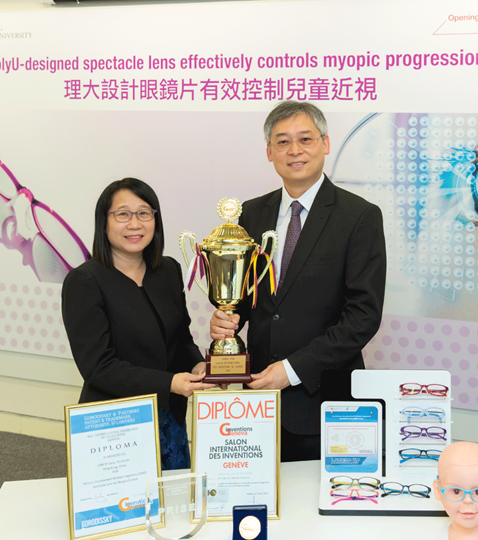
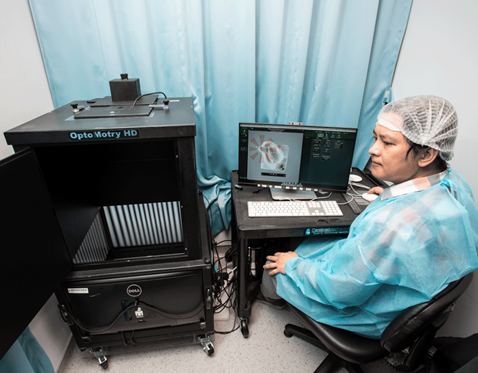
Using dual-power lenses and animal models for proof of concept, we found that early eye growth responds to simultaneously imposed myopic and hyperopic defocus. This led us to develop dual-power lenses, engineered to provide visual correction and myopic defocus concurrently. Our research between 2007-2014 confirmed that this form of myopic defocus, induced by the positive powered area of these dual-power lenses, effectively inhibits axial elongation in several animal species including chicks, guinea pigs, and monkeys [R1-R4].
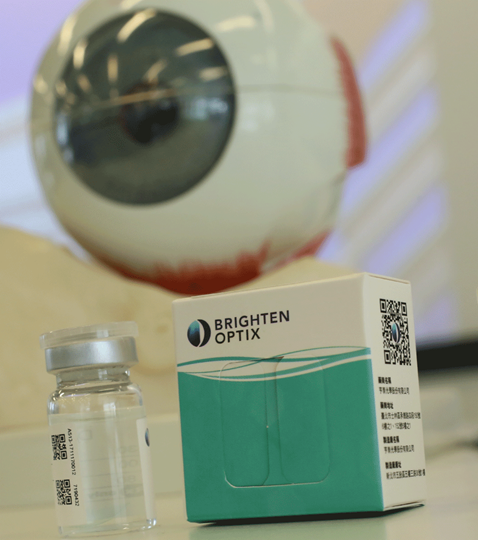
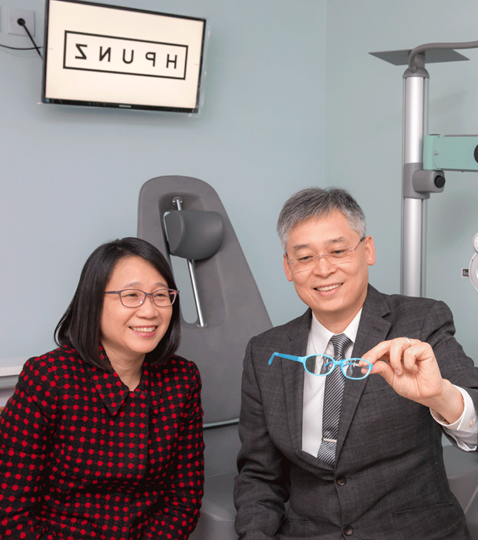
PolyU President's Awards for Outstanding Achievement in Knowledge Transfer (KT)
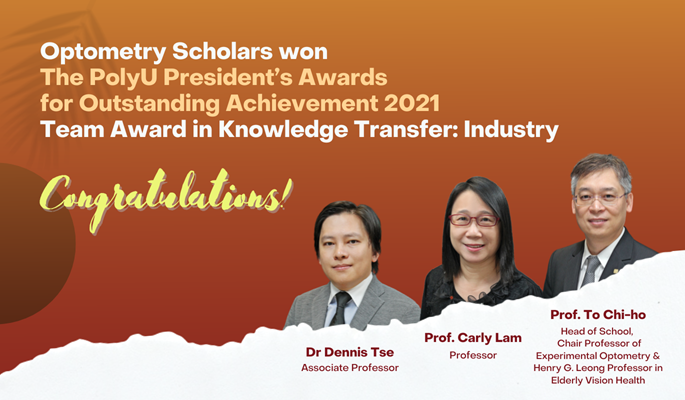
References to the research
Publications
- [R1] Tse DY, Lam CS, Guggenheim JA, Lam C, Li KK, Liu Q, et al. Simultaneous defocus integration during refractive development. Invest Ophthalmol Vis Sci. 2007;48(12):5352-9.
- [R2] Tse DY, To CH. Graded competing regional myopic and hyperopic defocus produce summated emmetropization set points in chick. Invest Ophthalmol Vis Sci. 2011;52(11):8056-62.
- [R3] Arumugam B, Hung LF, To CH, Holden B, Smith EL, 3rd. The effects of simultaneous dual focus lenses on refractive development in infant monkeys. Invest Ophthalmol Vis Sci. 2014;55(11):7423-32.
- [R4] McFadden SA, Tse DY, Bowrey HE, Leotta AJ, Lam CS, Wildsoet CF, et al. Integration of defocus by dual power Fresnel lenses inhibits myopia in the mammalian eye. Invest Ophthalmol Vis Sci. 2014;55(2):908-17.
- [R5] Lam CS, Tang WC, Tse DY, Tang YY, To CH. Defocus Incorporated Soft Contact (DISC) lens slows myopia progression in Hong Kong Chinese schoolchildren: a 2-year randomised clinical trial. Br J Ophthalmol. 2014;98(1):40-5.
- [R6] Lam CS, Tang WC, Tse DY, Lee RPK, Chun RKM, Hasegawa K, et al. Defocus Incorporated Multiple Segments (DIMS) spectacle lenses slow myopia progression: a 2-year randomised clinical trial. Br J Ophthalmol. 2019, doi: 10.1136/bjophthalmol-2018-313739.
Details of key research grants
- RGC GRF (B-Q04G) Control of myopia progression in myopic children using simultaneous vision approach (PI: Prof. Carly Lam), 1/2007 to 6/2010, HKD$893,500
- The Hong Kong Polytechnic University, Niche Area Fund (J-BB7P) Myopia Control: Freeing the world from sight-threatening myopia, (Coordinating PI: Prof. Carly Lam), 3/2008 to 3/2013, HKD$10,000,000
- RGC GRF (B-Q29M) Modulation of mammalian ocular growth with competing defocus (PI: Prof Carly Lam) 1/2012 to 6/2015 HKD$925,000
- Industrial fund from HOYA Lens Thailand Ltd. Myopia Control for Young Children with Myopic Defocus Incorporated Spectacles Lens (PI: Prof. Carly Lam), 5/2014 to ongoing, HKD3,120,400
- Industrial fund from Johnson & Johnson Vision Care Inc. Myopia Control Using Optimized Optical Defocus in Schoolchildren—a 12 Months Randomized Double Masked Control Trial (PI: Prof. Carly Lam), 1/2019 to 11/2020, HK$4,680,000
- RGC RIF (3-RC2C) Effectiveness of Bright Light Therapy, Myopic Defocus, Atropine and the Combinations for Controlling Myopic Eye Growth in Schoolchildren: A Randomized Control Trial (PI: Prof. Chi Ho To), 6/ 2019 to 6/ 2023, HKD$11,500,000
- HMRF (K-ZC1N) Does Blue-Light Filtering Spectacle Lens Promote Myopia Progression in Schoolchildren? (PI: Dr Rachel Chun), 6/2018 to 5/2021, HKD$1,199,600

Details of the impact
Hong Kong and Mainland Population: Experimental results were successfully translated from the myopia research platform into innovative clinical applications. The successful control of myopia at an early age benefits individuals over their lifetime, preventing severe visual impairment and ocular complications due to high myopia development.
DIMS and DISC lenses are highly effective for controlling myopia progression and are non-invasive. The DIMS lens is also the treatment of choice for children under eight years of age and for those who cannot or do not wish to wear contact lens. Given the scale of the myopia problem, the potential benefit and market share for these therapeutic technologies are expected to be enormous. As of August 2019, the number of DIMS lenses sold in the market was ~130,000 in Hong Kong and the Mainland.
Industry: The developed technologies have been licensed to industrial partners for commercial use. Since the launch of the DIMS spectacle lens in the summer of 2018, Hoya has organized 3,787 seminars in Hong Kong and the Mainland, and attracted 75,569 practitioners to the workshops, seminars and talks [S3]. The company received positive feedback on the effectiveness of the lens for myopia control, and it foresees significant demand for the lens in Asian countries including Singapore, Malaysia and Korea.
Vision Science and Technology Co. Ltd. (VST), one of the licensed partners since 2017, reported that over 1,400 pairs of DISC lenses were prescribed in Hong Kong from June 2018 to June 2019. VST launched the DISC lens in China in April 2019, and ~3,000 pairs of lenses were prescribed by the end of June 2019 [S4].
Public Sectors: The DIMS lens is available to all eye care practitioners for prescription to the general public in both Hong Kong and the Mainland. At our optometry clinic at The Hong Kong Polytechnic University, ~1,000 pairs of DIMS lenses were prescribed from June 2018 to January 2019, representing ~25% of all the lenses prescribed during that period. To assist in the use and extend the impact of our research, we have offered 25 training workshops/seminars since September 2017, in which there have been a total of 13,400 participants.
Government: The innovation of spectacle intervention to retard myopia has been recognized by the Hong Kong government. In her public speech to congratulate the winners of the 46th International Exhibition of Inventions Geneva, the Chief Executive of Hong Kong cited the DIMS lens as a good example of government funding [S5]. The citation of this lens, to attract IT talent, also appeared in the “Innovation” booklet distributed by the Hong Kong Government Innovation and Technology Bureau [S6].
Global: SO has continued to play an active role in developing general guidelines for clinical use. Two faculty members from SO served on the international experts’ panels for two white papers published in February 2019, in a renowned ophthalmology and vision research journal [S7, S8].
[S1] Report posted in South China Morning Post, 14 Sep 2019, on the project to support disadvantaged children in Hong Kong with the myopia control lens.
https://www.scmp.com/news/hong-kong/health-environment/article/3027181/cutting-edge-glasses-short-sighted-children-under
[S2] Letter of appreciation: Participants of The Hong Kong Polytechnic University-HKIF 2019 project.
[S3] Letter of supports by the managing director of Hoya Lens Hong Kong Ltd. 23 Sep 2019.
[S4] Letter of supports by the director of Vision Science and Technology Co. Ltd. 9 Aug 2019.
[S5] Chief Executive's speech at the 46th Geneva International Invention Exhibition winners' reception. The HKSAR Government. 4 June 2018.
https://www.info.gov.hk/gia/general/201806/04/P2018060400779.htm
[S6] “Innovation” booklet distributed by Innovation and Technology Bureau. The HKSAR Government. July 2018.
https://goo.gl/xHrprA
[S7] White paper published by international myopia institute on clinical guidelines for managing myopia where our research is cited. Gifford KL, Richdale K, Kang P, Aller T A, Lam CS, Liu YM, Michaud L, Mulder J, Orr JB, Rose KA, Saunders KJ, Seidel D, Tideman JWL & Sankaridurg P. IMI - Clinical Management Guidelines Report. Invest Ophthalmol Vis Sci 2019; 60, M184-M203, doi:10.1167/iovs.18-25977.
https://www.ncbi.nlm.nih.gov/pubmed/30817832
[S8] White paper published by International Myopia Institute on interventions available for controlling myopia where our research is cited. Wildsoet CF, Chia A, Cho P, Guggenheim JA, Polling JR, Read S, Sankaridurg P, Saw SM, Trier K, Walline JJ, Wu PC & Wolffsohn JS. IMI - Interventions Myopia Institute: Interventions for Controlling Myopia Onset and Progression Report. Invest Ophthalmol Vis Sci 2019; 60, M106-M131, doi:10.1167/iovs.18-25958.
https://www.ncbi.nlm.nih.gov/pubmed/30817829



